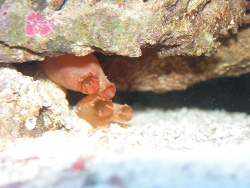Info
Styela plicata (Lesueur, 1823)
Styela plicata is able to tolerate changes in seawater between 10°-30°C,salinites between 22%-34%” as well as pollution and brackish water.
Synonymised names:
Ascidia cuviera Delle Chiaje, 1841 (misspelling)
Ascidia cuvieri Delle Chiaje, 1841 (original combination)
Ascidia patata Costa, 1844 (original combination)
Ascidia phusca Delle Chiaje, 1828 (original combination)
Ascidia plicata Lesueur, 1823 (original combination)
Phallusia sulcata Delle Chiaje, 1841 (original combination)
Styela gyrosa Heller, 1877 (original combination)
Styela pinguis Herdman, 1899 (original combination)
Styela pinguis Herdman, 1898
Tethyum plicata (Lesueur, 1823) (synonym)
Tethyum plicatum (Lesueur, 1823) (new combination)
Styela plicata is able to tolerate changes in seawater between 10°-30°C,salinites between 22%-34%” as well as pollution and brackish water.
Synonymised names:
Ascidia cuviera Delle Chiaje, 1841 (misspelling)
Ascidia cuvieri Delle Chiaje, 1841 (original combination)
Ascidia patata Costa, 1844 (original combination)
Ascidia phusca Delle Chiaje, 1828 (original combination)
Ascidia plicata Lesueur, 1823 (original combination)
Phallusia sulcata Delle Chiaje, 1841 (original combination)
Styela gyrosa Heller, 1877 (original combination)
Styela pinguis Herdman, 1899 (original combination)
Styela pinguis Herdman, 1898
Tethyum plicata (Lesueur, 1823) (synonym)
Tethyum plicatum (Lesueur, 1823) (new combination)







 Javier Couper (Predomalpha), New Zealand
Javier Couper (Predomalpha), New Zealand











